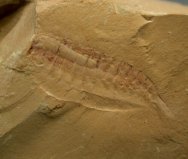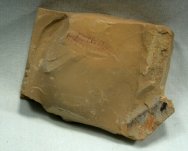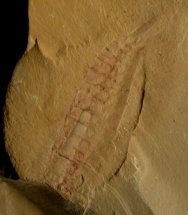Alalcomenaeus sp
Phylum Arthropoda, Subphylum Chelicerata, Class Megacheira, Family Alalcomeneidae
or, by some authors,
Phylum Arthropoda, Class Dinocaridida, Order Radiodonta, Family Opabiniidae
Geological Time: Early Cambrian (~525 million years ago)
Size: Fossil is 26 mm long
Fossil Site: Chengjiang Maotianshan Shales, Qiongzhusi Section, Yu'anshan Member, Heilinpu Formation, Maotianshan Hill, Yuxi, Chengjiang County, Yunnan Province, China
|
Alalcomenaeus is placed in a group called the Great Appendage arthropods that are generally not accepted to be monophyletic. What group members have in common is “great appendages” used in hunting and feeding. Perhaps the most famous members are the anomalocaridids that are renowned to have been trilobite predators, and sometimes called a “terror of the Cambrian” that may have grown to some two meters in length, making them the largest Cambrian animals known. Tanaka et al, (2013) did a neuroanatomical study of Chengjiang Alalcomenaeus fossils supporting placement of Great Appendage Arthropods in Subphylum Chelicerata (Clade Arachnomorpha) and new Class Megacheira. If so, it is further confirmation of the long held belief that as part of the great Cambrian metazoan radiation, these Chelicerates (i.e., spiders, scorpions, ticks, horseshoe crabs, eurypterids, etc.) branched from other arthropod lineages (i.e., insects, crustaceans and many more). Discovered in 1984, the Chengjiang Biota now ranks as the most diverse faunal fossil assemblage of all the Burgess Shale like deposits. It is also some 10 million years older than the Burgess Shale. Like the Burgess Shale, non-mineralized soft tissue parts are often extraordinarily well preserved with high resolution as aluminosilicate films, sometimes with oxidized iron content. Various taphonomic processes leading extensive preservation of soft tissue have been proposed, including rapid death by asphyxia followed by rapid burial in anoxic sediment undisturbed by turbidity. The Chengjiang biota is dominated by phyla Arthropoda and Porifera. There are seven lobopodians, more than any other Lagerstätte that some scientists elevate to phylum rank, and seven members of the extinct phylum Vetulicolia. Members or potential members of phyla Priapulida, Nematomorpha, Hyolitha, Hemichordata, Echinodermata, Ctenophora, Chordata, Cnidaria, Chaetognatha, and Brachiopoda are found. A large number of enigmatic animals of uncertain affinity are found as well, some of which may represent failed evolutionary experiments, or even new phyla that did not persist for long in the early Cambrian, or were rapidly replaced by more derived forms. Among the diverse Maotianshan Shales fauna, of utmost important are the putative early chordates, particularly Haikouella, potentially an ancestor to or the earliest craniate chordate. Myllokunmingia and Haikouichthys are interpreted as early Craniata, and possibly very primitive agnathids, the progenitor of the fishes and all vertebrates. References:
Also see: Chengjiang Biota Chengjiang Fossils Cambrian Explosion |


